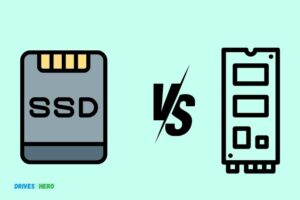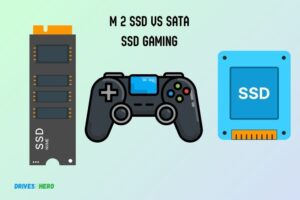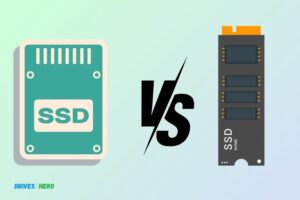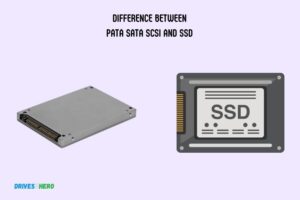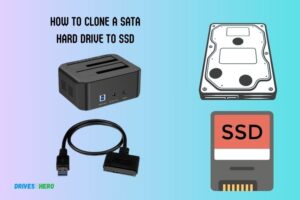Gaming Nvme Vs Sata Ssd: Which Is Better?
When it comes to gaming performance, NVMe SSDs typically outperform SATA SSDs.
NVMe SSDs use the PCIe (Peripheral Component Interconnect Express) interface, which supports higher data transfer rates compared to SATA interface, resulting in faster game load times and smoother gameplay.
NVMe (Non-Volatile Memory Express) SSDs are a newer technology compared to SATA (Serial AT Attachment) SSDs.
NVMe SSDs use a more direct path to your CPU through the PCIe bus, which allows for faster data transfer.
This makes them particularly advantageous for gaming, where fast data transfer rates can significantly cut down game load times and reduce lag.
While SATA SSDs offer decent performance for gaming and are compatible with a wide range of systems, they cannot match the speed offered by NVMe SSDs.
NVMe SSDs provide a significant performance boost, especially with regards to game load times and reducing lag, which can enhance your overall gaming experience.
However, they are more expensive than SATA SSDs and require a compatible motherboard.
8 Features Of Gaming Nvme Vs Sata SSD
| Feature | Gaming NVMe SSD | SATA SSD |
|---|---|---|
| Speed | Up to 3500 MB/s | Up to 550 MB/s |
| Capacity | Up to 4TB | Up to 4TB |
| Price | More expensive | Less expensive |
| Performance in Gaming | Better | Good |
| Power Consumption | Less | More |
| Interface | PCIe | SATA III |
| Data Transfer Efficiency | High | Moderate |
| Boot Times | Faster | Slower |
Key Takeaway

Five Facts About Gaming Nvme Vs Sata Ssd
Understanding The Difference Between Nvme And Sata Ssds
NVMe and SATA SSDs have crucial differences for gaming, affecting speed and performance.
While NVMe SSDs offer lightning-fast speeds through direct PCIe connections, SATA SSDs are more affordable and provide sufficient performance for most gaming needs.
Understanding these distinctions can help gamers make informed choices for their storage solutions.
How Nvme And Sata Ssds Have Revolutionized Storage In Gaming Pcs
Gaming PCs have come a long way in terms of storage technology. Traditional hard drives have been replaced by solid-state drives (SSDs), providing faster loading times and improved overall performance.
Among SSDs, two popular options are NVMe (Non-Volatile Memory Express) and SATA (Serial ATA) SSDs.
Understanding the difference between these two can help gamers optimize their storage solutions. Let’s explore the advantages and disadvantages of both NVMe and SATA SSDs.
Advantages Of Nvme And Sata Ssds:
Nvme Ssds:
- Lightning-fast speeds: NVMe SSDs leverage the PCIe (Peripheral Component Interconnect Express) interface to deliver exceptional read and write speeds. This translates into reduced game loading times and faster file transfers.
- Enhanced performance: The increased bandwidth and low latency of NVMe SSDs significantly improve overall system performance and responsiveness.
- Compact form factor: NVMe SSDs are typically smaller in size, making them a great choice for compact gaming PC builds or laptops.
- Efficient multitasking: NVMe SSDs handle heavy workloads and multiple tasks simultaneously, ideal for gamers who enjoy multitasking while gaming.
- Future-proof technology: With ongoing advancements in storage technology, NVMe SSDs are expected to remain at the forefront, offering improved performance and compatibility with upcoming gaming software and hardware.
Sata Ssds:
- Cost-effective option: SATA SSDs are more budget-friendly compared to NVMe SSDs, making them a popular choice for gamers on a tighter budget.
- Wide compatibility: SATA SSDs use the universally accepted SATA interface, allowing seamless integration with a variety of devices, including older gaming PCs and consoles.
- Sufficient speed for gaming: While SATA SSDs may not offer the same lightning-fast speeds as NVMe SSDs, they still provide a significant performance boost over traditional hard drives, resulting in faster load times for games.
- Ample storage capacity: SATA SSDs usually offer higher storage capacities compared to NVMe SSDs at a similar price point, allowing gamers to store more games and files on their devices without sacrificing performance.
Disadvantages Of Nvme And Sata Ssds:
Nvme Ssds:
- Higher cost: NVMe SSDs tend to be more expensive than their SATA counterparts, which can be a deterrent for gamers on a tight budget.
- Limited compatibility: Older gaming systems or motherboards may not have the necessary support for NVMe SSDs, requiring additional upgrades or compatibility checks before installation.
Sata Ssds:
- Slower speeds: Although SATA SSDs offer improved performance compared to traditional hard drives, they are slower than NVMe SSDs due to constraints of the SATA interface.
- Saturated bandwidth: SATA SSDs utilize the same bandwidth for data transfer as other SATA devices, such as hard drives and optical drives. This can lead to reduced performance when multiple devices are used simultaneously.
Choosing between NVMe and SATA SSDs depends on individual requirements and budget constraints. NVMe SSDs offer blazing-fast speeds and superior performance, making them a top choice for gamers demanding the best experience.
On the other hand, SATA SSDs provide a cost-effective solution with wider compatibility and ample storage capacity.
Understanding the strengths and weaknesses of both options allows gamers to make an informed decision when upgrading their gaming PCs’ storage solutions.
Nvme Ssds For Ultimate Gaming Performance
Discover the ultimate gaming performance with NVMe SSDs, the perfect alternative to SATA SSDs. Elevate your gaming experience with faster load times and smoother gameplay.
Harnessing The Power Of Nvme Ssds For Faster Load Times And Smoother Gaming Experiences
NVMe SSDs have revolutionized the gaming industry by providing superior performance compared to traditional SATA SSDs. With NVMe (Non-Volatile Memory Express) technology, gamers can experience faster load times and smoother gameplay.
Let’s explore how NVMe SSDs enhance gaming performance:
Lightning-fast load times: NVMe SSDs leverage the PCIe (Peripheral Component Interconnect Express) interface, allowing for significantly faster data transfer rates compared to SATA SSDs.
This means games load quicker, reducing those annoying wait times and getting you into the action faster.
Low latency, seamless gameplay: NVMe SSDs also boast ultra-low latency, enabling rapid data access and minimizing lag during gameplay.
This translates to smoother and more responsive gaming experiences, where every move and action register instantly, giving you a competitive edge.
Higher throughput and multitasking: Thanks to their high-speed data transfer rates, NVMe SSDs offer greater bandwidth, allowing for faster file transfers, quicker game installations, and faster software updates.
Additionally, the improved multitasking capabilities of NVMe SSDs ensure that you can handle resource-intensive tasks while gaming without compromising performance.
Improved asset streaming and open-world games: Open-world games with vast environments and numerous assets require continuous streaming of data.
NVMe SSDs excel in this aspect, as they handle asset streaming more efficiently, reducing pop-in textures, improving rendering speeds, and ensuring a seamless gaming experience.
Examining The High-Speed Data Transfer Rates And Low Latency Of Nvme Ssds
NVMe SSDs are known for their blistering-fast data transfer rates and minimal latency.
Here’s a closer look at these impressive features:
Data transfer rates: NVMe SSDs harness the power of the PCIe interface, delivering significantly higher data transfer rates compared to their SATA counterparts.
With NVMe, sequential read and write speeds can reach astonishing levels, enabling rapid access to large gaming files, reducing bottlenecks, and optimizing overall system performance.
Low latency: In gaming, latency can be the difference between winning and losing. NVMe SSDs shine in this department, boasting incredibly low latency due to their streamlined architecture and parallel processing capabilities.
This means that data retrieval occurs almost instantaneously, resulting in reduced input lag, smooth gameplay, and improved responsiveness.
Queue depth and IOPS: Another advantage of NVMe SSDs is their superior input/output operations per second (IOPS) and increased queue depth.
These factors enhance the drive’s ability to handle multiple read and write requests simultaneously, ensuring smooth multitasking, faster load times, and improved system responsiveness.
Nvme Ssd Compatibility And Installation Considerations For Gaming Pcs
Before upgrading to an NVMe SSD for gaming, there are a few important considerations to keep in mind:
- Motherboard compatibility: NVMe SSDs require a compatible motherboard with an available M.2 slot and proper PCIe support. Ensure that your motherboard supports NVMe SSDs before making a purchase.
- Form factors: NVMe SSDs come in different form factors, including M.2 and add-in card (AIC) formats. Verify your PC’s compatibility and available slots for installing the NVMe SSD.
- Cooling and heat dissipation: NVMe SSDs can generate considerable heat during intense gaming sessions. Ensure that your PC has adequate cooling solutions, such as heatsinks or fans, to prevent thermal throttling and maintain optimal performance.
- Installation: Installing an NVMe SSD usually involves inserting it into the appropriate slot, securing it with a screw, and connecting it to the motherboard. Ensure you follow the manufacturer’s instructions and take necessary precautions, such as grounding yourself, to avoid static electricity damage.
By harnessing the power of NVMe SSDs, gamers can elevate their gaming experiences to new heights.
Whether it’s faster load times, smoother gameplay, or improved multitasking capabilities, NVMe SSDs are a game-changer in the pursuit of ultimate gaming performance.
Sata Ssds: A Cost-Effective Storage Solution For Gamers
SATA SSDs offer a cost-effective storage solution for gamers, providing reliable performance without breaking the bank.
With faster load times and improved gameplay, they are a viable alternative to NVMe SSDs for gaming enthusiasts.
Exploring The Affordability And Reliability Of Sata Ssds For Gamers:
In the world of gaming, storage is everything. Gamers need a storage solution that is not only fast and reliable but also affordable.
This is where SATA SSDs come into play. These solid-state drives offer an optimal balance between performance and cost, making them an excellent choice for budget-conscious gamers.
Let’s delve deeper into the affordability and reliability of SATA SSDs, comparing them with traditional HDDs in terms of speed and performance, and discussing some considerations for gaming enthusiasts on a budget.
Sata Ssds Vs. Traditional Hdds: A Showdown Of Speed And Performance
When it comes to speed and performance, SATA SSDs leave traditional HDDs in the dust.
Here’s a comparison of the two storage options:
SATA SSDs: With their lightning-fast read and write speeds, SATA SSDs significantly reduce game loading times and provide snappy responsiveness.
Whether it’s launching a game, loading a new level, or saving progress, SATA SSDs excel in delivering a seamless gaming experience.
Additionally, these drives have no moving parts, resulting in reduced latency and virtually no noise.
Traditional HDDs: On the other hand, traditional HDDs rely on spinning platters and mechanical arms to retrieve data.
This mechanical nature causes slower data access times, resulting in longer loading screens and potential performance bottlenecks.
HDDs are more prone to failure due to their mechanical components, which can affect data integrity and overall reliability.
In terms of speed and performance, SATA SSDs are unbeatable when compared to traditional HDDs. Upgrading to an SSD can transform your gaming experience by offering faster load times and smoother gameplay.
Sata Ssd Options And Considerations For Gaming Enthusiasts On A Budget
If you’re a gaming enthusiast looking for an SSD on a budget, here are some considerations:
Capacity: SATA SSDs are available in different storage capacities, typically ranging from 120GB to 2TB. Consider your gaming needs and the size of your gaming library when choosing the appropriate capacity. Keep in mind that larger capacities usually come at a higher price point.
Price: SATA SSDs are generally more cost-effective than other storage options like NVMe SSDs. While NVMe drives offer faster speeds, SATA SSDs deliver a good balance of performance and affordability.
When comparing prices, look for SSDs that provide the best value for money within your budget.
Brand and Reliability: It’s important to choose a reputable brand known for producing reliable SSDs. Look for reviews and ratings to gauge the reliability and durability of the drive you’re considering.
A reliable SSD will ensure data integrity, reducing the risk of losing your valuable game saves and files.
Lifespan and Warranty: Consider the lifespan and warranty of the SATA SSD you’re interested in. SSDs have limited write endurance, but most modern drives are designed to last for several years.
Look for SSDs with longer warranties to safeguard your investment against any potential issues.
By taking these considerations into account, you can find a suitable SATA SSD that meets your budget requirements without compromising on performance and reliability.
SATA SSDs are an affordable and reliable storage solution for gamers. They offer faster speeds and improved performance compared to traditional HDDs.
With a wide range of options available, you can choose an SSD that fits your budget while still providing an excellent gaming experience.
So, level up your gaming setup by embracing the speed and affordability of SATA SSDs.
Factors To Consider When Choosing Between Nvme And Sata Ssds
Choosing between NVMe and SATA SSDs for gaming involves considering important factors such as speed, performance, and cost.
While NVMe SSDs offer faster data transfer rates and quicker load times, SATA SSDs are more affordable and suitable for budget-conscious gamers.
Ultimately, the decision depends on individual needs and budgetary constraints.
Determining The Specific Needs And Priorities Of Your Gaming Setup
Consider the requirements of your gaming setup: Before choosing between NVMe and SATA SSDs, it’s important to assess your specific needs and priorities.
Take into account factors such as the intensity of your gaming, the type of games you play, and the overall performance you expect. By understanding the requirements of your gaming setup, you can make a more informed decision.
Evaluate the importance of storage capacity: The storage capacity of an SSD is crucial when it comes to gaming.
Consider the size of your game library and whether you prefer having multiple games installed simultaneously.
Keep in mind that NVMe SSDs generally offer higher storage capacities compared to SATA SSDs, allowing you to store more games and other large files.
Assess the impact of speed on gaming performance: Speed is a critical factor for smooth gaming performance. NVMe SSDs typically have faster read and write speeds compared to SATA SSDs, resulting in reduced loading times and improved gameplay.
However, the difference in speed may not be noticeable for every game, so it’s worth considering whether the added speed justifies the higher cost of NVMe SSDs.
Consider the cost factor: Budget is an important aspect to consider when choosing between NVMe and SATA SSDs. Typically, SATA SSDs are more affordable compared to NVMe SSDs.
If cost is a major concern and you don’t require the fastest speeds or highest capacities, a SATA SSD might be the better option for your gaming setup.
Evaluating The Impact Of Storage Capacity, Speed, And Cost On Gaming Performance
Storage capacity: A larger storage capacity allows you to store more games and files on your SSD. Consider the size of your game library and the amount of data you regularly need to access.
NVMe SSDs generally offer higher storage capacities, making them suitable for gamers with extensive libraries or those who work with large files.
Speed: The speed of an SSD significantly impacts gaming performance. NVMe SSDs utilize the PCIe interface, offering faster read and write speeds compared to SATA SSDs that rely on the SATA interface.
The increased speed translates to reduced loading times and improved overall gaming experience. However, the difference in speed might not be noticeable for all games, so assess whether it justifies the higher cost of NVMe SSDs.
Cost: Budget plays a vital role in the decision between NVMe and SATA SSDs. SATA SSDs are typically more cost-effective than NVMe SSDs, allowing gamers on a tighter budget to still enjoy the benefits of solid-state storage.
If you’re looking for an affordable option and don’t require the fastest speeds or highest capacities, a SATA SSD can be a practical choice.
Understanding The Compatibility Requirements Of Nvme And Sata Ssds With Your Motherboard
Check the motherboard’s compatibility: Before deciding between NVMe and SATA SSDs, ensure that your motherboard supports the chosen type of SSD.
NVMe SSDs require an M.2 slot or an expansion card with an NVMe interface, whereas SATA SSDs are compatible with standard SATA ports. Refer to your motherboard’s manual or specifications to identify the supported SSD types.
Determine the available slots: Check the number of available expansion slots on your motherboard to accommodate the chosen SSD.
NVMe SSDs usually require an M.2 slot, while SATA SSDs can be connected to SATA ports. Make sure you have the necessary slots to install the SSD of your choice.
Consider drive bay limitations: Some gaming setups may have limited drive bays or restrictions on the number of SSDs that can be installed.
Evaluate whether your setup can accommodate additional SSDs and whether it supports NVMe or SATA connections. Plan accordingly to ensure compatibility with your gaming system.
By evaluating these factors—your specific needs, storage capacity, speed, cost, and compatibility—you’ll be able to make an informed decision between NVMe and SATA SSDs for your gaming setup.
Remember to consider your gaming requirements, desired performance, and budget to find the most suitable option.
Real-World Performance Comparison: Gaming With Nvme Ssds Vs Sata Ssds
Discover the ultimate gaming experience with NVMe SSDs versus SATA SSDs. Unlock lightning-fast load times and seamless gameplay with the unbeatable real-world performance of NVMe technology.
Upgrade your gaming rig and elevate your performance to the next level.
Analyzing Benchmark Results And Real-World Gaming Scenarios:
- NVMe SSDs offer faster data transfer speeds compared to SATA SSDs.
- The improved performance of NVMe SSDs can lead to faster game loading times and reduced stuttering.
- Benchmark tests reveal that NVMe SSDs consistently outperform SATA SSDs in terms of read and write speeds.
- However, in real-world gaming scenarios, the difference in performance may not always be as noticeable.
- While NVMe SSDs excel in handling large game files and open-world environments, the impact on overall gaming experience can vary depending on the game and its optimization.
- SATA SSDs, although slower in speed, can still provide excellent performance for most games and deliver seamless gameplay.
- Factors like CPU and GPU capability, RAM capacity, game optimization, and overall system configuration also contribute to the gaming experience.
Highlighting Performance Differences Between Nvme And Sata Ssds:
- NVMe SSDs utilize a PCIe interface, allowing them to achieve faster data transfer rates and lower latency.
- NVMe SSDs typically have higher sequential read and write speeds, resulting in quicker file access and game loading times.
- In contrast, SATA SSDs use the traditional SATA interface, limiting their speed to the SATA bus speed.
- SATA SSDs may still offer fast enough speeds for many games, especially those not heavily dependent on large file transfers.
- The performance disparity between NVMe and SATA SSDs becomes more apparent in scenarios where intensive data processing is required, such as transferring large files or working with high-resolution media.
Considering The Potential Gaming Benefits And Limitations Of Each Storage Option:
NVMe SSDs:
Benefits:
- Faster game loading times, reducing wait times and allowing players to jump into the action more quickly.
- Quick data transfer speeds for large game files, ideal for open-world games with expansive environments.
- Reduced stuttering and improved overall game performance, particularly when dealing with frequent data streaming.
Limitations:
- Higher cost per gigabyte compared to SATA SSDs.
- Potential for higher power consumption, resulting in increased system heat generation.
- Limited performance impact on games optimized for consoles or low-end hardware.
SATA SSDs:
Benefits:
- Good overall game performance for most titles, providing satisfactory loading speeds and smooth gameplay.
- Cost-effectiveness, as SATA SSDs are generally more affordable compared to NVMe options.
- Lower power consumption, making them suitable for laptops or systems with limited cooling capabilities.
Limitations:
- Slower data transfer speeds compared to NVMe SSDs, resulting in longer game loading times.
- Limited performance in handling large game files or data-intensive tasks.
- Reduced advantage in scenarios requiring high-speed data processing or when working with large media files.
NVMe SSDs offer significant speed advantages over SATA SSDs, especially in scenarios involving large file transfers and data-intensive tasks.
However, the impact on gaming performance depends on various factors and may not always be as pronounced in real-world gaming scenarios.
SATA SSDs, on the other hand, provide a cost-effective storage solution with satisfactory gaming performance for most titles.
The choice between NVMe and SATA SSDs ultimately depends on individual needs, budget, and the level of performance required for specific gaming scenarios.
Future Of Gaming Storage: Nvme Or Sata?
The future of gaming storage lies in the choice between NVMe and SATA SSDs. Both offer high-speed performance, but NVMe is emerging as the preferred option for gamers seeking maximum speed and responsiveness.
Exploring Emerging Technologies And Trends In Gaming Storage
In the ever-evolving world of gaming, storage technology has become a crucial component for a seamless gameplay experience.
Two prominent contenders in the gaming storage landscape are NVMe and SATA SSDs. Each offers unique advantages and limitations.
Let’s delve into the emerging technologies and trends in gaming storage to understand the future landscape better.
Predicting The Future Dominance Of Nvme Or The Resilience Of Sata
NVMe (Non-Volatile Memory Express):
- Lightning-fast Speeds: NVMe utilizes the PCIe interface, enabling significantly higher data transfer rates, resulting in faster load times and reduced latency.
- Enhanced Performance: With its parallelism and ability to handle multiple commands simultaneously, NVMe provides gamers with smoother gameplay and quicker access to game files.
- Growing Popularity: As NVMe SSDs continue to become more affordable, they have gained popularity among gamers looking for top-notch performance.
SATA (Serial Advanced Technology Attachment) SSD:
- Cost-Effectiveness: SATA SSDs offer a budget-friendly option without compromising on basic gaming storage requirements.
- Compatibility: SATA SSDs are compatible with a wide range of gaming consoles, making them readily accessible to console gamers.
- Established Technology: SATA has been the standard for gaming storage for a significant period, providing a reliable and trusted option for gamers.
Discussing Potential Advancements That May Bridge The Gap Between The Two Storage Options
Advancements in NVMe technology:
- Increased Affordability: As technology advances and economies of scale come into play, NVMe SSD prices are expected to decrease, making them more accessible to a wider demographic of gamers.
- Higher Capacities: NVMe SSDs are continually pushing the boundaries of storage capacity, offering more room for larger game files and downloadable content (DLC).
- Enhanced Compatibility: NVMe SSD manufacturers are working towards better compatibility with gaming consoles, bridging the current gap between SATA and NVMe.
Improvements to SATA SSDs:
- Augmented Speeds: SATA SSDs are also undergoing enhancements to boost their speed capabilities, narrowing the gap with NVMe in terms of load times.
- Increased Durability: By implementing stronger and more resilient components, SATA SSDs can withstand heavy gaming usage, ensuring longevity.
- Enhanced Storage Efficiency: SATA SSD manufacturers are exploring methods to maximize storage capacity and optimize gaming performance within the limitations of SATA technology.
As gaming technology progresses, it is difficult to determine which storage option will dominate the future of gaming.
NVMe’s remarkable speed and performance make it an attractive choice for enthusiasts, while SATA SSDs continue to provide a reliable and cost-effective solution for a broader gaming audience.
However, with ongoing advancements in both NVMe and SATA technologies, it’s plausible to anticipate a future where these two options converge, offering an optimal gaming experience to all.
FAQ For Gaming Nvme Vs Sata Ssd
Is An Nvme Ssd Worth It Over Sata?
Yes, an NVMe SSD is worth it over SATA due to its faster speed and improved performance.
Does Nvme Ssd Speed Matter For Gaming?
Yes, the speed of NVMe SSD does matter for gaming, as it improves loading times and overall performance.
Is Nvme Really Faster Than Sata Ssd?
Yes, NVMe is faster than SATA SSD due to its advanced design and direct connection to the motherboard.
Is Sata Ssd Better Than Pcie For Gaming?
SATA SSD is usually better than PCIe for gaming due to its high speed and performance.
Can Gaming Performance Be Improved With An Nvme Ssd?
Yes, gaming performance can be significantly improved with an NVMe SSD. The faster read and write speeds of NVMe SSDs result in reduced loading times and improved overall gameplay.
Conclusion
When choosing between a gaming NVMe and a SATA SSD for your gaming needs, it’s crucial to consider factors such as speed, capacity, and cost.
NVMe drives, with their faster data transfer rates, are ideal for gamers who demand quick loading times and want to optimize their gaming experience.
However, they tend to be more expensive and offer smaller storage capacities compared to SATA SSDs.
On the other hand, SATA SSDs provide ample storage space at a more affordable price point, making them a good option for gamers on a budget.
Both options have their own advantages and drawbacks, so it ultimately depends on your specific needs and preferences.
Whether you prioritize speed or price, it’s worth noting that both NVMe and SATA SSDs provide significant improvements over traditional hard drives, ensuring a smoother and more enjoyable gaming experience for gamers of all levels.

